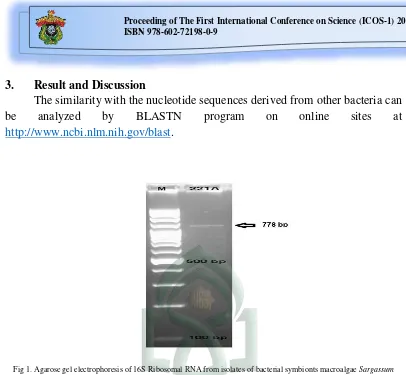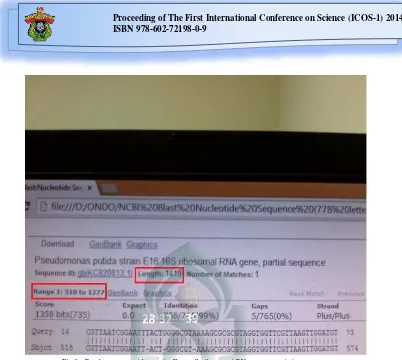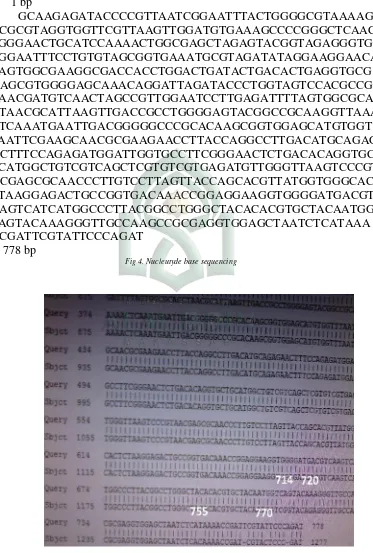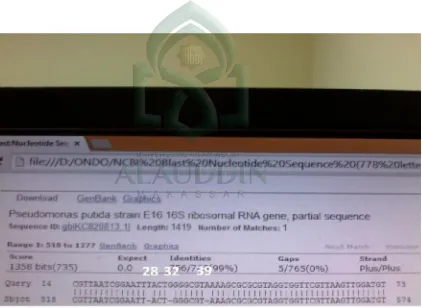ii
Proceeding
The First International Conference on Science
(ICOS-1)
Editors
Chief : Magdalena Litaay M.Mar.Sci, Ph.D
Member : Dr. Nurtiti Sunusi M.Si
Dr. Fachruddin M.Si
Reviewer
Prof. Dr Dahlang Tahir M.Si (Physics, UNHAS)
Sri Astuti Thamrin M.Stat, Ph.D (Mathematics & Statistics, UNHAS)
Paulina Taba M.Phil, Ph.D (Chemistry, UNHAS)
Dr. Eddy Soekendarsi M.Mar.Sci (Biology, UNHAS)
___________________________________________________________
Publisher: Fakultas Matematika dan Ilmu Pengetahuan Alam UNHAS
Address: Jl. Perintis Kemerdekaan KM 10 Tamalanrea 90245 Makassar
Tlp (0411) 586016, Fax (0411) 588551
Email: [email protected]
iii PREFACE
Makassar city, the capital of South Sulawesi province known as one of the biggest cities in Indonesia and also having Hasanuddin University, the biggest university in eastern part of Indonesia, has plenty of natural resources and human resources. Having a strategic position at the center point of Indonesia, Makassar has been developing very rapidly, and has been contributing to the regional, national and even international economic development. Given this, science can play important roles and therefore is needed to support rapid development in various sectors. With regard to this, cooperates with Ministry of Environment Indonesia, Atmospheric and Ocean Research Institute (AORI) Japan, University of Kebangsaan Malaysia (UKM), Alfred Wagener Institute (AWI) Germany, Queensland University of Technology (QUT) and Flinders University Australia, Faculty of Mathematics and Natural Sciences Hasanuddin University carried out “The First International Conference on Science (ICOS-1)” on November 19-20, 2014, in Hotel Clarion Makassar. The theme of ICOS-1 is “Science Enhancement for Developing Countries”. The conference attended by two hundred participants and came from Asia (Japan, Malaysia, Indonesia), Australia, and Europe.
There are approximately 97 research articles for oral presentations and 16 poster presentations, ranging from Biology, Statistics, Mathematics, Chemistry, Physics, Geophysics, Computer Science and Environmental Science. Of the 113 papers, there are approximately 79 papers were selected to be published in the proceedings of the ICOS-1 through the peer review process.
With regard to the delivery of the ICOS-1 in 2014 and the completion of the proceedings ICOS-1, 2014, allow us to thanks to: the authors for providing the content of the program, the conference participants who came from several public and private universities, the program committee and the senior program committee, who worked very hard in reviewing papers and providing feedback for authors to be included in the Proceedings of ICOS-1, 2014, the hosting organisation Hasanuddin University, our keynote and invited talk presentations including Ir. Muh Ilham Malik M.Sc, from Ministry of Environment Indonesia, Prof Koji Inoue from AORI Japan, Prof Mohammad B Kassim from UKM Malaysia, Dr.rer.nat Dominik Kneer from AWI Germany, Prof Dadang A. Suriamihardja and Prof Alfian Noor from Hasanuddin University, Prof Kerrie Mengersen from QUT and Dr. Darfiana Nur from Flinders University, Australia.
Hopefully is of benefit to all readers.
Yours faithfuly,
Prof Dr. Hanapi Usman M.S
iv TABLE OF CONTENTS
COVER ………. i
PREFACE …………..………. iii
TABLE OF CONTENTS ……… iv
KEYNOTE SPEECH
Muh Ilham Malik and Gunawan. Indonesian Policy on Hazardous Substances, Hazardous Waste, Contaminated Site Remediation and Domestic Waste
Management ………1-9
Mohammad B Kassim. Extending the Photo Response of Titanium Dioxide Photo Electrode with Ruthenium-tungsten Dye-sensitiser
……… 10 Dadang A. Suriamihardja. Understanding Economic Sustainability from Thermodynamic Viewpoint
……… 11-20 Koji Inoue, Irma Andriani and Zainal Arifin. Oryzias Fishes: Important Scientific Resources in Sulawesi
……… 21-27 Kerrie Mengersen. Bayesian Modelling and Analysis of Big Data
……… 28 Alfian Noor. Exploring Sponge Role in Alleviating Metal Pollution of Coastal Marine Environment: Some Experimental Results in Eastern Indonesia
………..…29-33 Dominik Kneer, Simona Laukaityte, Leonardo Calderon Obaldia and Ruth Lewo Mwarabu. The Impact of Climate Change on Coral Reefs, and the Mitigation Potential of Sea Grasses
……… 34 Darfiana Nur and James Totterdell. Bayesian Hidden Markov Model for Homogeneous Segmentation of Simian Vacuolating Virus (sv40)
v ORAL PRESENTATION
I. BIOLOGY
B.1. Asriyanti, Magdalena Litaay, Eva Johannes, Indah Raya. The Effect of Fe3+ Ion Addition towards The Omega-3 (DHA) Production on Phytoplankton
Chlorella vulgaris
……… 36-42
B.2. Rahmi Rozali. Selection of Isolates of Azotobacter Sp. Rhizosphere of Plants Cocoa and Ability in Dissolving Phosphate
……… 43-48
B.3. Eka Sukmawaty. Testing of Bacillus Thuringiensis Subsp. Aizawai Toxin,
Beauveria bassiana Conidia and Mix Cultured to Armyworm (Spodoptera Litura) ……… 49-55
B.4. Mu’minah, Baharuddin, Hazarin Subair, Fahruddin. Production of Exopolysaccharide (Eps) Isolated From Bacterial Potato Rhizosfer on Several Sources of Carbon
……… 56-63
B.5. Haerunnisa, Ahmad Yani, Lismawati. Study of Relationship and Similarities Test Tawes Fish Barbonymus gonionotus and Nilem Fish Osteochilus hasselti in Tempe Lake through and Methods Morphometric Meristic.
……… 64-73
B.6. Kafrawi, Baharuddin, Enny L. Sengin, Ade Rosmana. Exploration of Free-living Rhyzobacteria from Shallot in Sulawesi Island and their Phosphate Solubilizing Activity
……… 74-82
B.7. Zulkifli Razak, Muhammad Arif Nasution, Suryawati Salam. Seed Technology Adoption Grafting Seed of Passion Fruit (Passiflora Edulis)
vi B.8. Mashuri Masri. Molecular Identification of Bacterial Simbiont Macroalgae
Sargassumpolycystum Producing Enzymes L-Asparaginase.
………. .88-95
B.9. Magdalena Litaay, Risco B. Gobel, Dody Priosambodo, Syahribulan, Zaraswati Dwyana, Nur Haedar, Elsye Pabalik. The Tropical Abalone Halitosis Asinina L, Screening For Antimicrobial Activity of its Bacterial Symbiont.
……… 96-103
B.10. Isna Rasdianah Aziz. Potency of Pseudomonas Aeruginosa as Bioremediation Using Diazinon
……… 104-108
B.11. Dody Priosambodo, Dominik Kneer, Harald Asmus, Neviaty P. Zamani, Karen von Juterzenka, Magdalena Litaay, Eddy Soekendarsi. Community Analysis of Burrower Shrimp in Bone Batang Seagrass Bed South Sulawesi ……… 109-119
B.12. Adriani Mutmainnah, Eddyman W. Ferial, Muhtadin. The Structure of Seagrass Community in Barrang Lompo Island, Makassar South Sulawesi
……… 120-128 B.13. Andi Ilham Latundra, Indah Raya, Raymond Kwangdinata, Isran Asnawi Abd. Karim, M.Syahrul. Production of Biodiesel Based on Microalgae Tetraselmis chuii and Chlorella vulgaris Lipids Used Ultrasonic Method.
……… 129-142
II. STATISTICS
S.1. Georgina Maria Tinungki. Determining Estimation on Semi Parametric Regression on Measurement Error
……….. 143-151 S.2. Poppy Indrayani, Yasuhiro Mitani, Ibrahim Djamaluddin, HiroIkemi. Construction of a Geospatial Data Sharing and Mutual-Use using by GIS Technology
……… 152-157 S.3. Muhammad Arif Tiro. Occupation and Profession of Statisticians
vii S.4. Endang Wahyu Handamari, Kwardiniya Andawaningtyas, Sobri Abusini. Comparison of Naïve Bayes Classifier and Back Propagation Method to Determine Suitable Contraception
………168-174 S.5. Shane E. Perryman. Mapping the Unkown: Measuring Change at The Microbial Level Using Molecular Method and Multivariate Statistics.
………175-183 S.6. Suci Astutik, Henny Promoedyo, Solimun. ZIG Model on Intermittent and Positively Skewed Rainfall Data
……….. 184-190 S.7. Aswi, Sukarna. Spatial Pattern of 2013 Dengue Incidence in South Sulawesi ………191-198 S.8. Indah Mulia Sari, Sri Astuti Thamrin, Armin Lawi. Piecewise Exponential Frailty Model on Survival Data using Bayesian Approach
……… 199-210 S.9. Rima Ruktiari, Sri Astuti Thamrin, Armin Lawi. A Weibull Regression Model Using Additive Frailties on Survival Data
……… 211-218 S.10. Fachrul Nawawi, Erna Tri Herdiani, Nurtiti Sunusi. Estimating Vector Autoregressive - Generalized Space Time Autoregressive Parameter with Seemingly Unrelated Regression
………219-225 S.11. Sukarna, Aswi. On the Non-Negativity of Probability Density Functions ………226-231 S.12. Yusran, Erna Tri Herdiana, La Podje Talangko. Application of Hotelling’s𝑇2 Control Chart Based on the Mean Square Successive Difference in Monitoring Makassar City’s Weather Conditions
……… 232-238 S.13. Giarno, Erna Tri Herdiani, Nurtiti Sunusi. Term of Combination and Recombination in Time Series
………239-246
III. MATHEMATICS
M.1. Aidawayati Rangkuti. Expectation Value in Risk Decision Making
...………...247-251 M.2. Endah RM Putri, Lukman Hanafi, Zakiyyah AM. Finite Difference Method for Pricing European Option Under the Heston Model
viii M. 3. Chairul Imron, Sentot Didik S. The influence of Reynolds Number on the Drag Coefficient of a Circular Cylinder
……… 258-262 M.4. Dwi Ratna Sulistyaningrum, Budi Setiyono. The Defect Detection on Bullet P production using Edge Detection and Euclidian Distance.
……… 263-267 M.5. Marjono, C.A. Ferima. Estimation of Least Upper Bound on the Modulus of Starlike Function Coefficients.
………..268-271 M.6. Sabri, Ilham Minggi. Students’ Difficulties in Mathematics Proofs
………..272-280 M.7. Naimah Aris. Regularity of Global Attractor for a Quasilinear Parabolic Equations with M-Laplacian Type
………281-289 M.8. Nur Erawaty. Equivalence Rational Matrices at Infinity
………..290-298 M.9. Selvi Rajuati Tandiseru. Development of Teaching Materials Based Local Culture in Improving the problem Solving Ability of Students’ mathematical ……… .299-305 M.10. Syafruddin Side. Solution of Poisson Equation with Boundary Element Method
………..306-314
IV. CHEMISTRY
C.1. Fathur Rahman Ma’rifatullah, Indah Raya, Hasnah Natsir. The Temperature Efect on Synthesis of Hydroxyapatite Nanocrystal Through
Precipitation Methode C.3. Kasmawaty Iswar, Indah Raya, Maming.Effect Stirring Time Variations of Synthesis Hydroxyapatite of Blood Shells (Anadara Granosa)
………..327-332 C.4. Lydia Melawaty, Alfian Noor, Tjodi Harlim, Nicole de Voogd.. Clathria reinwardtiias As a Zooremediator of Heavy Metal Manganese (Mn)
ix ………..339-344 C.6. Diana Eka Pratiwi, Suriati Eka Putri. Characterization of Banana Peel Briquettes with the Variation of Binder Concentration
………..345-351 C.7. Isran Asnawi, Hasnah Natsir, Nunuk Hariani. Exploration of Lipolytic Enzymes Microbes from Lemo Susu Hot Spring, Pinrang, South Sulawesi, Indonesia
………. 352-361 C.8. Syamsidar HS, Nurfaidhah Natsir. Bioremediation and Phytoremediation of Waste Oil Contaminated Soil using Biokompos with Sengon Plants
………..362-367 C.9. Sitti Chadijah, Andi Wahyu Trifany. Kinetics Delignification of Bagasse with Alkaline Peroxide Process.
………..368-375 C.10. Nunuk Hariani, Firdaus, Nursiah La Nafie, Nur Umriani Permatasari, Ajuk Sapar. A preliminary Study of Spons Species from Kapoposang Island, Spermonde Archipelago and Bioactivity Test of their Methanol Extracts
………..376-381 C.11. Aisyah, Rahmawati Azis, Yunizar. Synthesis of Fatty Acid Ethyl/ Methyl Ester from Candlenut Oil Utilizing Ultrasonic Device
………..382-387 C.12. Maming, Erny Rosmawati, Paulina Taba, Jabal Nur Basir, Indah Raya. Synthesis of Biomaterial Hydroxyapatite from Egg Shells and Its Potency as Material for Remineralization of Teeth
………..388-393 C.13. Muliadi, Deasy Liestianty, Zulkifli Tuara. Study on Toxicity of Ni2+ ion to the Growth of Marine Phytoplankton Dunaliella Salina in Conwy Medium
………..394-399
V. ENVIRONMENTAL SCIENCE
ES.1. Dewi Yanuarita, M. Rijal Idrus, Irwanto. Communties Vulnerability of Spermonde Coral Islands
………..400-408 ES.2. Akbar Tahir, Farid Samawi, Yeis Pairunan, Masrul Jaya. Assessment of Pb Metal Concentrations on Water Column, Sediment and Organisms at Kayangan Island Waters of Makassar City
x ES.3. Iradhatullah Rahim, Halima Tusadiyah, Muh. Iqbal Putera, Suherman, Asmaul Husna. The Utilization of An Agricultural Waste As A Source of Organic Matter of Nutrients in Maize
………..419-424
VI. COMPUTER SCIENCE
CS.1 Mohammad Isa Irawan, Daryono Budi Utomo. Optimization model of Planting Pattern Management Based on prediction of artificial Neural Network ………..425-446 CS.2. Marji, Dian Eka Ratnawati, Achmad Basuki. Random Search Method to Build the Software Special Diet Nutrition Patients (Running on Android)
………. 447-453
VII. PHYSIC
P.1. Syamsir Dewang, Bannu, Nurhasanah. Measurement of Radiation Dose on Radiodiagnostic X-ray machine with a Tube Voltage and Current Variations ………..……....454-461 P.2. Wira Bahari, Hariati, Sri Suryani. Characters of Temporal and Electric Potential Function from ECG for Patients with LVH Cardiac Abnormalities ………. 462-469 P. 3. Andi Nurul Aeni Daud, Aswar Syafnur, Harjumi, Indah Nurul Mutiah. Soil Density and Moisture Measurement Using Electrical Density Gauge (EDG) In ‘S’ Area
……… 470-474 P.4. Nurul Muhlisah, Sernita Domapa, Muhammad Taufiq Rafie, Andi Tenri Awali Wildana. Determination of Lithology and RQD (Rock Quality Designation) Value Using Well Logging and Full Coring In ‘T’ Area
……… 475-481
B. POSTER PRESENTATION
Po.1. Nur Haedar, Asadi Abdullah, Ruslan Umar, Ambeng. Production of Poly-Β-HydroxyButyrate (PHB) by Isolates Bacteria from Sugar Factory Waste on Some Substrate Molasses Concentrations
xi ……… 488-492 Po.3. Ismail Marzuki. Isolation and Identification on Degradator Bacterium of Petroleum waste which Symbions with Sponge from Melawai Beach ……… 493-503 Po.4. Nirmalasari Idha Wijaya, Triyanto. The Influence of Eye Stalk Ablation to Gonadal Maturity of Mud Crab Scylla Serrata That Cultivated on Battery Cell Cage ……… 504-509 Po.5. Juhriah, A. Masniawati, Mir Alam .Genetic Diversity of 1st Generation Selfing Local Corn of Selayar Regency South Sulawesi And Corn From Cimmyt Based on Simple Sequence Repeat (Ssr) Molecular Marker
……….510-517 Po.6. Zaraswati Dwyana, Nurul Muthmainnah. Production and Optimization Anti diarrheal Agent from Potency of Lactobacillus acidophilus at the Variation pH and Temperature
………..……….. 518-523 Po.7. Rosana Agus. Characterization Of Recombinant Protein Esat-6 Mycobacterium Tuberculosis As Immunodiagnostic Latent Tuberculosis
……… 524-529 Po.8. Nur Aliah Rusman, Magdalena Litaay, Zaraswati Dwyana, Nur Haedar, Elmi Zainuddin, Kurniati Umrah Nur. Bioactivity of Sponge Clatria sp Symbiotic Bacteria against Staphylococcus aureus and Salmonella typhi.
……… 530-536 Po.9. Waode Nur Rahmaniah, Alfian Noor, Muhammad Zakir, Maming. Utilization of diethanolamin as CO2 absorbent for measurement of Carbon-14 in Coral Sample from Langkai Island
……….537-543
Po.10. Andi Asdiana Irma Sari Yusuf, Maming, Muhammad Zakir, Alfian Noor. Utilization of Ethanolamine as Carbon Dioxide Absorber for Estimating of Coral Age from Langkai Island via LSC (Liquid Scintillation Counting) Method ……… 544-551 Po.11. Febby Kurniaty, Maming, Muhammad Zakir, Alfian Noor. Utilization of Sodium Hydroxide as Absorber for 14C Analysis of Coral Ages Estimation in Langkai Island Using LSC (Liquid Scintillation Counting) Method
……… 552-559 Po.12. Agnes Rantesalu, Nursiah La Nafie, Syarifuddin Liong. Synthesis of Silver Nanoparticles using langsat peel Extract Lansium domesticum
xii Po.13. Tuti Suprianti, Indah Raya, Hasnah Natsir. Effectiveness Extract of Fatty Acids of Microalga Chlorella Vulgaris as a Cream to Repair The Face Skin Texture
- 88 -
MOLECULAR IDENTIFICATION OF BACTERIAL
SIMBIONT MACROALGAE Sargassum polycystum
PRODUCING ENZYMES L-ASPARAGINASE
Mashuri Masri
Biology Department, Sciene and Technology Faculty, Islamic state University of Alauddin Makassar, South Sulawesi, Indonesia 92113. [email protected]
Abstract
Molecular Identification of bacterial Simbiont Macroalgae Sargassum polycystum Producing Enzymes L-Asparaginase were isolated from Barrang Lompo Island South Sulawesi in 2013. Among them three bacterial strains exhibiting glutaminase free L-asparaginase activity were identified as Pseudomonas putida, Enterobacter asburine dan Marinobacter arcticus on the basis of 16S rRNA gene sequencing. The Highest Max Score 1358 and Query Cover 98 % were Pseudomonas putida furthermore identified as bacterial L-asparaginase activity from Sargassum sp. Pseudomonas putida has Identities 756/765 (99%) with 778 bp Query length, Query cover 98% and Gaps 5/765 (0%).
Keywords : L-Asparaginase, Pseudomonas putida, bacterial Simbiont Macroalgae Sargassum polycystum.
1. INTRODUCTION
Interaction of secondary metabolites produced by marine bacteria associated with probable cause bacteria induced to produce a specific bioactive metabolites. According Nofiani (2008), these bacteria have the ability similar to the host to produce bioactive compounds.
Most algae that have different bioactivity ranging from antibacterial, antifungal, anticancer and etc were a group of brown algae, mainly from
Sargassum and Turbinaria group. Some types of brown algae, among others
Sargassum cinereum, Sargassum hemiphyllum, Sargassum polycystum,
Sargassum echinocarpum and Turbinaria decurrens were found in the waters of South Sulawesi (Rashid, 2001).
Asparaginase is one component of nutrition for cancer cells. Giving of L-Asparaginase in cancer cells can decompose L-Asparagine which is expected to inhibit the growth of these cells. L-Asparaginase of great benefit in cancer therapy (E-Moharam, et al, 2010), one of them is a cervical cancer cells.
2. METHODOLOGY 2.1 DNA Ekstraction
- 89 - ml micro-tubes containing 560 mL of buffer AVL then vortex for 1 minute and incubated at room temperature for 10 minutes. Tubes were centrifuged for a while to reduce fluid tube attached to the lid, then added 560 mL of absolute ethanol into the tube and vortex 1 minute. A total of 630 mL mixture inserted into the column and then centrifuged at 8000 rpm for 1 minute in orther the solution out of the column and into the reservoir tube and then discarded, while the DNA remained in the column. Column washed with wash solution containing ethanol that is AW1 and AW2 respectively by adding 500 mL and centrifuge at 8000 rpm for 1 minute. To remove excess wash solution that may remain in the column, centrifuge at 12,000 rpm for 1 minute. Reservoir tube was then replaced with 1.5 ml sterile eppendorf tube. To release the DNA trapped in the column added 60 mL elution solution AVE (AVE buffer) and then incubated at 50 º C for 1 minute. Centrifugation at 12,000 rpm for 1 minute, liquid containing the DNA deposited in a sterile tube(Samaila, A., 2013).
2.2 DNA Amplification
A master mix containing 1 mL U1, U2 1 mL, 5 mL 10X buffer, 2 mL 25 mM MgCl2, 1 mL of 10 mM dNTPs, 0.25 mL of hot start, 29.75 mL H2O and 10 mL of DNA. Dissolving 10 mL of supernatant and 40 mL master mix so that the total volume of 50 uL sample then put in a PCR machine. PCR cycle stages, namely denaturation, annealing and extension, carried out at a temperature of 94ºC for 30 seconds, 50ºC for 30 seconds and 72ºC for 1 minute 30 seconds for the second stage (stage 35 cycles to 30 cycles for the first and second stage). PCR cycle begins with a pre-denaturation step at 94ºC for 5 minutes and ended with a final extension step at 72ºC for 5 minutes (Samaila, A., 2013).
2.3 Gel Agarose Electroforesis
A 2% agarose was used in this study. A total of 5 mL ethidium bromide solution (10 mg / mL) was added to the agarose gel, TAE solution was then added to the electrophoresis tank to cover the upper surface of the gel. Into each well, put 5 mL of PCR product was mixed with 1 mL after loading dye solution (40% sucrose, 0.25% bromophenolblue). In one of the wells included 5 mL (0.5 mg) of DNA molecular weight marker XIV (100 bp) as a DNA size standard. Electrophoresis device is run by giving power to the voltage to 80 volts (V) for 30 minutes. Once the process is complete agarose gel electrophoresis, the gel was entered in a Gel Doc XR, Biorad, USA (Samaila, A., 2013).
2.4 Sequencing
- 90 - 3. Result and Discussion
The similarity with the nucleotide sequences derived from other bacteria can be analyzed by BLASTN program on online sites at
http://www.ncbi.nlm.nih.gov/blast.
Fig 1. Agarose gel electrophoresis of 16S Ribosomal RNA from isolates of bacterial symbionts macroalgae Sargassum polycystum.
16S Ribosomal RNA gene expressed by SBJCT while the sample is expressed with QUERY. There are 778 bp Query length. The length of the 16S Ribosomal RNA gene was used for 1419 bp with a range of 518 bp to 1277 bp. The use of 518 bp to 1277 bp by the system because in that section is the closest approximation to the nucleotide sequence of the sample with 98% cover query value (Fig 2 and Fig 3).
Molecular identification of the identification results is Pseudomonas putida
- 91 - Fig 2. Psedomonas putida strain E16 16S ribosomal RNA gene, partial sequence
- 92 - 1 bp
GCAAGAGATACCCCGTTAATCGGAATTTACTGGGGCGTAAAAG CGCGCGTAGGTGGTTCGTTAAGTTGGATGTGAAAGCCCCGGGCTCAAC CTGGGAACTGCATCCAAAACTGGCGAGCTAGAGTACGGTAGAGGGTG GTGGAATTTCCTGTGTAGCGGTGAAATGCGTAGATATAGGAAGGAACA CCAGTGGCGAAGGCGACCACCTGGACTGATACTGACACTGAGGTGCG AAAGCGTGGGGAGCAAACAGGATTAGATACCCTGGTAGTCCACGCCG TAAACGATGTCAACTAGCCGTTGGAATCCTTGAGATTTTAGTGGCGCA GCTAACGCATTAAGTTGACCGCCTGGGGAGTACGGCCGCAAGGTTAAA ACTCAAATGAATTGACGGGGGCCCGCACAAGCGGTGGAGCATGTGGT TTAATTCGAAGCAACGCGAAGAACCTTACCAGGCCTTGACATGCAGAG AACTTTCCAGAGATGGATTGGTGCCTTCGGGAACTCTGACACAGGTGC TGCATGGCTGTCGTCAGCTCGTGTCGTGAGATGTTGGGTTAAGTCCCGT AACGAGCGCAACCCTTGTCCTTAGTTACCAGCACGTTATGGTGGGCAC TCTAAGGAGACTGCCGGTGACAAACCGGAGGAAGGTGGGGATGACGT CAAGTCATCATGGCCCTTACGGCCTGGGCTACACACGTGCTACAATGG TCAGTACAAAGGGTTGCCAAGCCGCGAGGTGGAGCTAATCTCATAAA ACCGATTCGTATTCCCAGAT
778 bp
Fig 4. Nucleutyde base sequencing
- 93 - Identities of 756/765 (99%). This means that there are 756 bp in common between the query and Sbjct of 765 bp. There are 9 differences from 5 bp experiencing insertion (named gaps) and 4 bp experiencing substitution.
This four substitution seen in figure 5 that the Query 714 bp, 720 bp, 755 bp, 770 bp. The first substitution occurs in the Query 714 bp in the form of A but in the form of G in Sbjct 1215 bp. The second substitution occurs in the query 720 bp in the form of A but in the form of G in Sbjct 1221 bp. The third substitution occurs in the query 755 bp in the form of T but in the form of C in Sbjct 1256 bp. The fourth sub stitution occurs in the query 770 bp in the form of T but in the form of C in Sbjct 1270 bp.
- 94 - Fig 7. 2 bp experiencing insertion
Gaps of 5/765 (0%). It is intended that the queries 765 bp long and 5 are gaps with Sbjct, ie, on the order of 28 bp, 32 bp, 39 bp, 765 bp and 775 bp that occurs due to insertion at the Query (contained in the query but not found in sbjct).
The total insertion are five, there are three insertions in figure 6, ie 28 bp, 32 bp, 39 bp and two insertions in figure 7, ie 765 bp and 775 bp.
There are three possibilities of bacteria ie Pseudomonas putida with Max score 1358. QC (query cover) = 98%. Marinobacter arcticus with Max score 1356. QC = 97% and Enterobacter asburiae with Max Score 1356. QC = 97%. From these results determined that the strain of Pseudomonas putida E16 16S ribosomal RNA gene (Accession KC820813.1) is a bacterial symbiont of macro algae Sargassumpolicystum.
4. CONCLUSION
Pseudomonas putida E16 16S ribosomal RNA gene (Accession KC820813.1) is a bacterial symbiont of macro algae Sargassumpolicystum.
5. BIBLIOGRAPHY
[1] E-Moharam, M., Gamal-Eldeen, A.M., dan El-Sayed, S.T., 2010,
Production, Immobilization and Anti Tumor Activity of L – Asparaginase of Bacillus sp R36, Journal of American Science, Vol. 6.
- 95 - [3] Nofiani, R., 2008, Urgensi dan Mekanisme Biosintesis Metabolit Sekunder
Mikroba Laut.
[4] Rasyid, A., 2001, Potensi Sargassum Asal Perairan Kepulauan Spermonde sebagai Bahan Baku Alginat, Kandidat Peneliti Puslitbang Oseanologi, LIPI, Jakarta.




